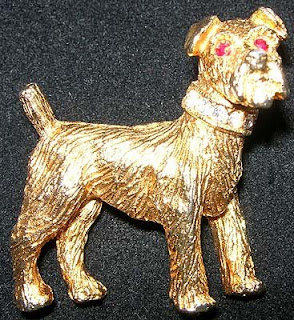Pricing or valuing jewelry is probably one of the most difficult areas for the dealer or collector. Unlike fine jewelry (which, if nothing else, can be melted down for its gold content), costume jewelry has no intrinsic value. So determining what a piece is worth can be quite the trick.
When assigning a value to pieces in
The Dog Jewelry Museum (DJM), there are a number of approaches that are used. First is finding comparable prices. Just like with real estate, it helps to be able to look at what others are charging for the same or similar items. Keep in mind that to be truly comparable, the pieces need to be exact matches and in
the same condition.
Sites reviewed include
Ebay,
Ruby Lane,
E-crater, and individual online websites (see
The Dog Jewelry Museum Friends for a list of good sites to visit). Keep in mind that most of the time, prices on Ebay will be lower than most of the other venues. Ruby Lane, other online malls and websites will offer pieces at retail price. The range from an Ebay wholesale price (of course sometimes a bidding war on Ebay will drive prices much higher than you might see elsewhere) to a high end retail price gives a general idea of the current value of the piece.
Another way value is determined is by what price is paid for the item. The Dog Jewelry Museum attains pieces by buying online from wholesale, retail, and auction sites and offline from rummage, estate, and private sales. Pieces are also donated to the Museum from artisans, collectors, and dealers. When a donated piece is received, the value supplied by the donor (when available) is used in the listing. When a piece is purchased, that price is used along with comparables to establish a range of value. Often in DJM listings, a range will be listed. The bottom of the range is the lowest price found and the top is the highest found. Again, this is taking into account that the piece is an exact match to that valued and that conditions are similar.
Condition does present an issue in valuation. If a piece is not in excellent condition, the value goes down. Generally speaking, a piece in very good condition will be valued 10-25% less than one in excellent condition. A piece in good condition will be valued 50-75% less than one in excellent condition, and a piece in fair or poor condition will have a minimal value assigned. The only exception to this is if the piece is exceedingly rare and highly collectible.
What exactly is "exceedingly rare" and "highly collectible"? Exceedingly rare pieces are those that may not appear on the market in a decade or more. They may only be known by collectors from one example in a good reference book or perhaps from a premiere collection shared online. Or perhaps a
design patent is available that confirms details on a piece that may never have been seen in the marketplace.
Even if a piece is truly rare, it may not be highly collectible. Excellent design, fine craftsmanship, well known makers, and whimsical representation as well as condition all contribute to making a piece highly collectible. If a piece is both rare and collectible, then it will be more highly valued, even in a lesser condition, than common pieces in excellent condition.
Values for dog jewelry are not fixed. Markets change based on the economy, fashion, number of collectors, availability of pieces, and other factors. Recently, there have been more pieces previously thought to be rare coming on the market as collectors sell out or pass away. These infusions of "new" pieces are part of what makes valuing costume jewelry more an art than a science. The Dog Jewelry Museum curator views literally hundreds of pieces of dog jewelry each day and this provides a good picture of what the current market looks like. Values in DJM listings can and are changed to reflect the market as time allows.
What about book values? While they make interesting reading and it is fun to find a piece in the book, for the most part these values are unconnected to current market conditions. There is too much lag time from when the book is compiled to when it is published, to make values realistic. A good reference book is always helpful to a collector or dealer, but the price guides are academic information, at best.
Comparable prices, prices paid, rarity/collectibility, conditon, and market forces are the keys to valuing canine costume jewelry.















































